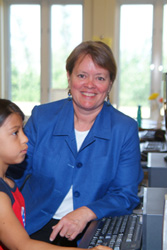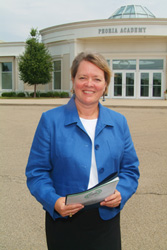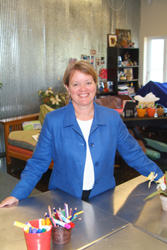
As principal of Peoria Academy for nearly seven years, Karen Calder upholds the idea of offering creative challenges to grade school children. Since the opening of the private, non-profit academy in 2000, the school has more than doubled in number of students and is exploring the prospect of expansion.
Beginning at DePauw University in Indiana, Calder earned a bachelor’s degree in psychology. Attending schools in North Carolina, Ohio and Illinois, she achieved her teaching certificate. In 1988, Calder received her master’s degree in special education from Illinois State University. Teaching in each of the above states (except Indiana), Calder eventually moved to Peoria and served District 150 for three years. In 1993, she was hired as the principal of Praise and Leadership Academy (PALS), where she continued until December 1999.
After 27 years of living in Peoria, Calder and her second husband now enjoy being “empty-nesters” as the last of their combined seven children heads off to college. She volunteers with the Junior League of Peoria, Rotary Club-North, Girl Scouts and First Federated Church, and spends most of her time supporting her school’s many events and programs. For fun, she says, “I love to read, cheer on the Bradley Braves and take trips to visit my family that is scattered all over the country.”
The Peoria Woman interviewed you in December 1998 when you were the principal of PALS. In 2000, you were asked by parents to begin Peoria Academy. Did the children of these parents attend PALS? Explain the development of Peoria Academy.
Peoria Academy was formed by a core group of parents who had children at Praise and Leadership Academy. This group of parents was looking to start an elementary school that would be independent and governed by a board of trustees. The group was fortunate enough to secure the Knights of Columbus Hall on Willow Knolls Road in the early spring of 2000. Renovations to the building began in early April. Our school opened in August 2000, with 137 students in kindergarten through eighth grade, with just one class per grade level. Additional construction was completed in phases throughout our first school year. These additions included our gym, seven additional classrooms and two additional restrooms. The second year we were in operation, we added a pre-kindergarten classroom and a second kindergarten. Next year, we’ll have two sections in grades K-5, plus a second seventh grade section. We hope to eventually have two classes at each grade level. Right now, we anticipate an enrollment of 365 for the fall of 2007.
You mentioned that you were looking for a school to send your children to when Peoria Academy was being developed. Was your daughter able to attend?
My youngest daughter, Margaret, was able to attend Peoria Academy for her seventh and eighth grade years. My other two daughters were older and were not able to attend the school. I loved having Margaret at the same school with me and sharing some of the same experiences with her.
Has your educational philosophy stayed the same or changed through the years? Explain.
My educational philosophy has remained the same throughout the years. I continue to believe that all children learn differently and that it is our responsibility as educators to provide students with learning opportunities that meet their needs. Each child comes to us with differing abilities and talents, and I believe it is important for us to help children discover and develop their individual talents. Schools need to be engaging and relevant. Learning should be fun.
Where did the first class of graduates go to high school, and how are they adjusting?
Actually, that first graduating class is now well into college, and they continue to do well. Our first graduating class of Peoria Academy had 11 students who scattered to various high schools throughout the Peoria area. One of our young men was a National Merit finalist as a senior in high school; one of our girls was on the Richwoods basketball team that won the state championship and one-third of the students in this first class finished in the top eight percent of their high school senior classes and qualified as Sterling Merit finalists. Th e Sterling Merit Committee also selects two students as “outstanding.” One of Peoria Academy’s graduates was selected as one of those “outstanding” students.
In subsequent years, we have had students who were valedictorians of their classes, class officers, additional Sterling Merit winners, homecoming queens and students who are now playing college basketball and soccer and earning scholarships.
What is involved with beginning a new school?
Beginning a new school involves a lot of teamwork, and we were very fortunate when our school first started to have many people who were willing to contribute their time and talents. From fundraising to construction, marketing, curriculum development, ordering supplies and furniture, hiring staff , managing our finances, admissions and creating school policies, we had to use the skills of everyone to get the school started. Looking back, it is amazing to think about what we were able to accomplish in such a short time frame.
 What makes Peoria Academy different from parochial and public schools in the area?
What makes Peoria Academy different from parochial and public schools in the area?
Our approach to teaching is different from many schools. We embrace a multi-sensory approach to learning, so much of our instruction is in small groups. During math, we may have four different activities going on in one room at the same time. Our school also has monthly general thematic units that tie together the entire school’s curriculum. While we are certainly aware of the state guidelines, our curriculum is more flexible, and we are able to move at a more advanced pace, when appropriate. Our teachers work collaboratively with the administrative staff to constantly refine and improve our curriculum.
In addition, we have special teachers that focus on science, music, art and foreign language instruction. We offer foreign language (Spanish) beginning in pre-K through eighth grade. We also offer French in fifth through eighth grades as part of the curriculum and have offered Chinese to all students in after-school lessons.
While we follow a traditional school schedule, we also offer a summer camp, holiday care and a variety of after-school lessons. The lessons have become very popular for students to explore their interests. Some examples of these lessons are: chess, dance, fencing, photography, Mad Science, art classes, book clubs, sports activities…and the list goes on.
As an independent school, we must rely on ourselves to fund the school. Th e majority of our income comes from tuition, with fundraising filling in the gaps.
How is Peoria Academy governed?
The Board of Trustees governs the school, and this group is made up of a combination of community members and parents. The Board of Trustees has various sub-committees which are open for parent participation. These committees help to develop policies for running our school. We also have a Parent Council that organizes various social events and activities for students and parents and helps in so many other ways that it would be tough to get along without them. The Board of Trustees and the Parent Council are critical to the success of our school.
Since Peoria Academy is private, what about the diversity of the students? What misperceptions exist, if any?
We’re certainly aware that many people have the belief that Peoria Academy is some kind of elitist school, and it’s a misconception we’re working hard to overcome. Most people have no idea of the diversity that exists among our families. Twenty percent of our students are from various racial or ethnic groups. We have students who come from 14 different countries. We have Jewish students, Christian students, Muslim students, Hindu students and Buddhist students.
A little over 10 percent of our students receive financial aid to attend Peoria Academy. We do not want cost to deter parents from considering this school for their child, so we make every effort to continue to build our scholarship fund.
Finally, our students’ abilities run the gamut from gifted and talented to those who sometimes struggle with their studies and may even be labeled as “learning disabled.” So, this school offers a very diverse environment for our children, and we do our best to meet the needs of each child.
What disciplinary procedures does Peoria Academy have that are different from public schools?
As a private school, we do have the option to decline admission to a student who has demonstrated behavior problems in his/her current school, so we find that we do not have the severity of problems that might exist in other schools. However, all children can and do make poor choices from time to time, and we have procedures and strategies for dealing with discipline problems. Most often, we are able to correct a situation by talking to students about their actions and helping them think about a better response the next time they encounter a similar situation. We involve parents whenever it is necessary. However, we use time out for younger students, detentions for middle school students, and for severe behavior problems that don’t respond to our strategies, we have the option to ask the student to leave our school.
Foreign language is offered beginning at kindergarten. What languages are offered and why is it important to today’s students?
Actually, our school offers Spanish as early as pre-kindergarten. Research supports that foreign language instruction, when begun early, is more easily learned by children. In the fifth grade, our students have the option to continue with Spanish, or they may start French classes. We also provide after-school lessons in Chinese for those who are interested. I do believe in the globalization of our economy; it is extremely important for children to be familiar with other cultures and be able to speak another language.
 Uniforms are required. Why does the board believe that is important?
Uniforms are required. Why does the board believe that is important?
When our school began, the decision to have uniforms was heavily debated. We surveyed parents and had several meetings to discuss the pros and cons of uniforms. We finally decided on a solution which would allow students to select their uniforms from a collection of clothing from two different vendors. Uniforms have certainly reduced the competition from designer clothing, and teachers don’t have to worry about clothing distracting from the learning process. I believe that when all the children are dressed in the same manner, you are more likely to see a child for who he/she is because he/ she is not disguised by their clothing.
How does Peoria Academy attract qualified teachers?
Our school environment attracts many qualified teachers to our school. The teachers find that they have well-equipped classrooms, adequate budgets to purchase classroom supplies, students interested in learning and supportive parents.
How does Peoria Academy keep parents and children motivated?
We try to keep everyone involved and informed. We work hard to build relationships with as many families as possible. We have social events (picnics, potlucks, movie nights), committees and volunteer opportunities in order to engage our families here at school. When everyone is having fun working together for a common goal—the best education for the children— we’re all motivated.
The children stay motivated because they are engaged in their learning. Their day is filled with creative activities that make learning enjoyable. At the end of each monthly theme, we have special events to look forward to as culminating experiences. For example, during our multicultural month, each grade level studies a different part of the world. At the end of the month, each classroom invites another classroom to tour their room and the children share with one another what they have learned. During “Blast from the Past” month, each classroom takes a different period of history as a focus. At the end of the month, we have a “Time Tunnel” throughout our hallways, complete with tour guides.
How does the curriculum change from year to year?
When our school started, we had an outline of the objectives to be accomplished for each year. Each year, we continue to re-evaluate those objectives for our school. As far as implementing the objectives, we give the teachers the freedom to implement different activities to achieve these objectives. Each year, we review our monthly themes and evaluate what changes we might like to make. We’re always open to new ideas.
With the growth of Peoria Academy, what are plans for building and/or continuing into high school?
With our growing school population, we will need to build an addition to our school in the very near future. We have plans to add a cafeteria and seven classrooms behind our gym to meet the needs of our students as they move through our middle school. Discussions about the next phases of our growth will most likely begin after we complete this project.
What do you see for the future of education in the preschool through middle school grades?
I hope that schools will continue to search for the right balance between testing and the joy of learning. I fear that in the pursuit of higher test scores, schools may narrow their focus of study to topics that are solely on the test. I recognize the importance of measuring student achievement, but we also have to be certain that children have the problem solving and analytical skills to apply this knowledge as well. In addition, children need to have a proper moral compass and social skills.
What would you like our readers to know that has not been discussed?
I feel very fortunate to have the opportunity to work at Peoria Academy. I love the freedom we have to be creative and to continue to learn with the children. TPW
